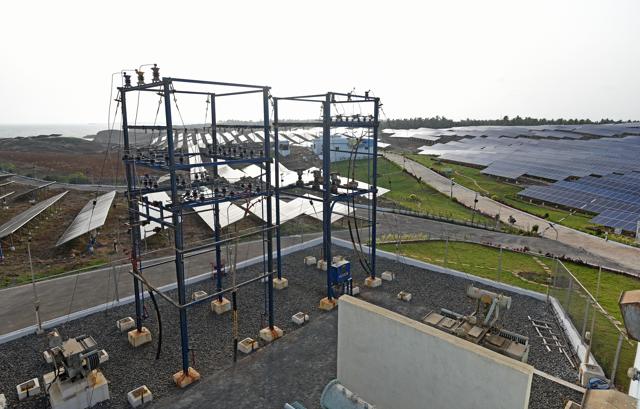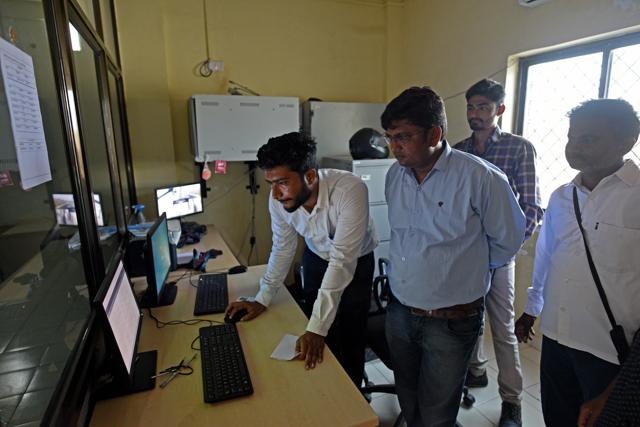It takes an island: How Diu became India’s first solar city by day
Large vacant plots owned by the government, long sunny months, and a small population made the district ideal for a renewable energy push.
Mahesh Solanki used to pay about ₹1.8 lakh a month for power. Last year, it dropped by about ₹15,000; last month by ₹15,000 again.

“With electricity costs rising everywhere, this was a pleasant surprise,” says Solanki, who owns a 36-room beach resort and two ice factories in the scenic beach town.
In September 2016, Diu became the first city in India to run completely on solar energy during the day. The power comes from its two solar parks — spread over of 0.2 sq km — and the rooftop panels on 112 government establishments.
In all, the two parks have a capacity of 10.27 MW, and operate for about 12 hours a day. Demand in this 42-sq-km city of 52,074 residents ranges from 5 MW to 7 MW.
Which means that through the day, the sun is powering all homes, the resorts with central air-conditioning, Diu’s 60-bed hospital, government buildings, air-conditioned office buildings, and the ice factories and fish warehouses that are its main power-consuming industries.
“Until the first park became operational, Diu did not generate any power and bought power from the Gujarat grid,” says Diu collector Hemant Kumar. “Now, we actually contribute to the grid during the day.”

WHY DIU?
The effort to turn Diu towards the sun began in 2013, when the first of its two solar parks was sanctioned by the Central Electricity Authority of India. It became operational by 2015; the second phase by 2016, though it was officially inaugurated by the prime minister in February this year.
There are a couple of factors that make this Union Territory district ideal for a solar project.
“The island has vast swathes of barren and rocky government land, coupled with a low population density and good solar exposure, with only about two months of cloudy weather a year,” Kumar says. “Even during these two months, all through 2017, we have found that we are able to meet daytime demand.”
Being a Union Territory also means Diu is under central government control, which made it easier to plan, fund, find land for and execute the solar parks project.
The entire effort has cost ₹62 crore; maintenance and running costs are minimal. “We need to hose down the panels regularly and make sure the connecting wires have not got loose. The cleaning bit is important because blurring of the glass surface can lower capacity,” says Paresh Patel, a junior engineer with the Daman & Diu electricity department.
The parks are managed by two companies, the public sector Bharat Heavy Electricals Limited and the private sector renewable power company Ujaas Energy.

At the control centres at each park, company employees can track the graph of power production through the day. At 6 am, the panels start to hum; they peak around noon, and begin to ebb at 6 pm.
Through the day, the excess power generated goes to the Gujarat grid; after dark, the district draws from the grid. There are plans to plug this gap too, switching from solar to wind after sundown.
“We hope to have four windmills sanctioned by the end of the year, which would have a capacity of about 6 MW,” says Kumar.
MONEY SAVER
In Fudam village, the sun shines bright over acres of thousands of solar panels laid out on a rocky hilltop overlooking the sea.
Because of these rows and rows of panels, which have essentially eliminated raw material and production costs, the Diu electricity department has been able to reduce power tariffs by about 12%, says Milind Ingle, executive engineer with the Daman & Diu electricity department.
“When we first heard about the project, we didn’t think it made sense. How can you run a fully air-conditioned resort with lifts and a pool on solar energy,” says Solanki. “But now we are seeing how solar power has actually improved things for the island.”
At the two-year-old Diu government hospital, panels covering the roof have a capacity of 120 KW, with the power going to the grid.

“Since it’s a government building, the net metering system doesn’t apply, but hospitals are usually huge spaces with major electricity consumption. Using open terraces for solar panels can cut this expenditure — which could also make healthcare cheaper,” says senior surgeon and hospital head Sanjay Verma.
A MODEL CITY?
How can Diu’s success be emulated for a bigger city? Well, for starters, the administration is finding it tricky to replicate even for Daman.
“Though they are twin territories, the same policy cannot be applied because Daman is a heavily industrialised area with very little free space,” says Milind Ingle, executive engineer with the Daman & Diu electricity department.
What can be done is to replicate the centralised generation model used to thermal energy production. Mumbai, for instance, gets most of its power from a coal-fired plants in Chhattisgarh; Delhi, from multiple plants in Uttar Pradesh.
“Since solar energy needs a lot of space, it would make sense to use barren land in non-prime rural areas,” says Ingle. It would also make sense to learn from the Diu model and start with the smaller territories.
As Ingle puts it, “A village can be lit with just 5-6 acre of land and at a cost of about ₹3 crore.”
Catch your daily dose of Fashion, Health, Festivals, Travel, Relationship, Recipe and all the other Latest Lifestyle News on Hindustan Times Website and APPs.



